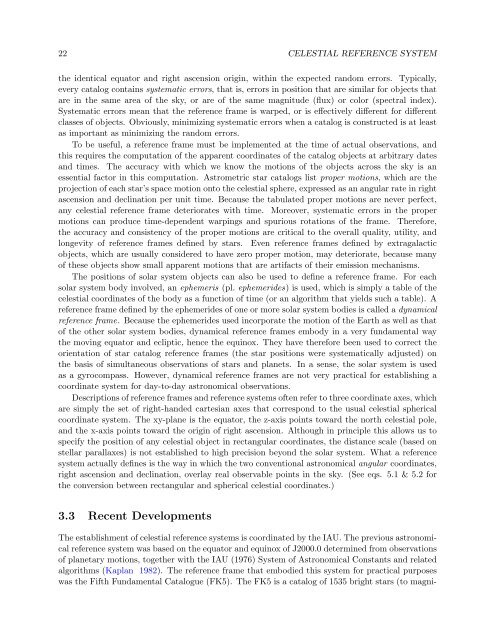USNO Circular 179 - U.S. Naval Observatory
USNO Circular 179 - U.S. Naval Observatory
USNO Circular 179 - U.S. Naval Observatory
You also want an ePaper? Increase the reach of your titles
YUMPU automatically turns print PDFs into web optimized ePapers that Google loves.
22 CELESTIAL REFERENCE SYSTEM<br />
the identical equator and right ascension origin, within the expected random errors. Typically,<br />
every catalog contains systematic errors, that is, errors in position that are similar for objects that<br />
are in the same area of the sky, or are of the same magnitude (flux) or color (spectral index).<br />
Systematic errors mean that the reference frame is warped, or is effectively different for different<br />
classes of objects. Obviously, minimizing systematic errors when a catalog is constructed is at least<br />
as important as minimizing the random errors.<br />
To be useful, a reference frame must be implemented at the time of actual observations, and<br />
this requires the computation of the apparent coordinates of the catalog objects at arbitrary dates<br />
and times. The accuracy with which we know the motions of the objects across the sky is an<br />
essential factor in this computation. Astrometric star catalogs list proper motions, which are the<br />
projection of each star’s space motion onto the celestial sphere, expressed as an angular rate in right<br />
ascension and declination per unit time. Because the tabulated proper motions are never perfect,<br />
any celestial reference frame deteriorates with time. Moreover, systematic errors in the proper<br />
motions can produce time-dependent warpings and spurious rotations of the frame. Therefore,<br />
the accuracy and consistency of the proper motions are critical to the overall quality, utility, and<br />
longevity of reference frames defined by stars. Even reference frames defined by extragalactic<br />
objects, which are usually considered to have zero proper motion, may deteriorate, because many<br />
of these objects show small apparent motions that are artifacts of their emission mechanisms.<br />
The positions of solar system objects can also be used to define a reference frame. For each<br />
solar system body involved, an ephemeris (pl. ephemerides) is used, which is simply a table of the<br />
celestial coordinates of the body as a function of time (or an algorithm that yields such a table). A<br />
reference frame defined by the ephemerides of one or more solar system bodies is called a dynamical<br />
reference frame. Because the ephemerides used incorporate the motion of the Earth as well as that<br />
of the other solar system bodies, dynamical reference frames embody in a very fundamental way<br />
the moving equator and ecliptic, hence the equinox. They have therefore been used to correct the<br />
orientation of star catalog reference frames (the star positions were systematically adjusted) on<br />
the basis of simultaneous observations of stars and planets. In a sense, the solar system is used<br />
as a gyrocompass. However, dynamical reference frames are not very practical for establishing a<br />
coordinate system for day-to-day astronomical observations.<br />
Descriptions of reference frames and reference systems often refer to three coordinate axes, which<br />
are simply the set of right-handed cartesian axes that correspond to the usual celestial spherical<br />
coordinate system. The xy-plane is the equator, the z-axis points toward the north celestial pole,<br />
and the x-axis points toward the origin of right ascension. Although in principle this allows us to<br />
specify the position of any celestial object in rectangular coordinates, the distance scale (based on<br />
stellar parallaxes) is not established to high precision beyond the solar system. What a reference<br />
system actually defines is the way in which the two conventional astronomical angular coordinates,<br />
right ascension and declination, overlay real observable points in the sky. (See eqs. 5.1 & 5.2 for<br />
the conversion between rectangular and spherical celestial coordinates.)<br />
3.3 Recent Developments<br />
The establishment of celestial reference systems is coordinated by the IAU. The previous astronomical<br />
reference system was based on the equator and equinox of J2000.0 determined from observations<br />
of planetary motions, together with the IAU (1976) System of Astronomical Constants and related<br />
algorithms (Kaplan 1982). The reference frame that embodied this system for practical purposes<br />
was the Fifth Fundamental Catalogue (FK5). The FK5 is a catalog of 1535 bright stars (to magni-


